The Tesla Inc. Strategic Analysis
Introduction.
In the environmental vehicle (EV) industry, Tesla, Inc. is currently a global leader with high brand recognition and customer loyalty. Tesla, Inc. products are not limited to EV manufacturing and sales but also include the expansion of charging stations, next-generation batteries, and intangible assets, namely the development of EV management software, including the autopilot feature. Tesla, Inc.’s primary market is the U.S. and Canada, with a share of over 2.5% of the industry’s total size, with Tesla, Inc. also well represented in Europe (1.8%) and China (1.6%) (Kane, 2022). Notably, this figure has shown steady growth over the past six years, so Tesla, Inc. is projected to increase its presence in domestic and foreign markets. The company’s mission is to accelerate the transition of global markets to sustainable energy consumption, with the corporate vision being to create the most attractive car company of the 21st century by driving the transition to EVs (Tesla, 2022d). For this reason, the brand’s core values are conscious risk-taking and experimentation, continuous learning, and respect, caring for the environment, and maximizing effort. This strategic report aims to provide business recommendations on future development for the Tesla, Inc.’s board

External Analysis
Examining the external environment of Tesla, Inc. allows identifying the key factors that affect the corporate development of the organization and assess growth opportunities. The following subsections include specific factors regarding Tesla, Inc., which are discussed using the PESTEL, Five Forces, and partial SWOT models.
Political Factors
Under the Obama and Trump presidencies, Tesla, Inc. received government benefits and enjoyed a lucrative offer stimulated by government support. However, with the arrival of Biden’s administration, the situation at Tesla, Inc. has changed almost diametrically. Although Biden, in the summer of 2021, triumphantly announced ambitious plans for the U.S. to increase the share of EV in the country to 50 percent by 2030, in reality, it proved to be a failure for Tesla, Inc. (Grandoni and Dennis, 2021). One clear example of Biden’s anti-Tesla, Inc. policy is a $4,500 subsidy to citizens as long as they buy EV from American-made companies created by the union 1 (Siddiqui, 2021). Meanwhile, Tesla, Inc. offers more environmentally friendly vehicles than gasoline or gas-powered passenger cars: as a consequence, U.S. resident users of Tesla, Inc. products are eligible to receive a tax deduction for promoting environmental safety, up to $7,500 (EPA, 2022a).
Economic Factors
The increasing share of EV manufacturers, Tesla, Inc.’s main product, in the national and global markets hurts the company’s economic well-being. Tesla, Inc. is still at the top of the EV brand rankings, but the agenda is rapidly shifting as competitors in the industry strengthen their position (Table 1.1). Nationally, economic growth and unemployment are expected to decline, which means, eventually, Tesla, Inc. will have to pay more to employees to maintain a favorable work environment (US BLS, 2022). The effect is amplified by growing competition because, as Figure 1.1 shows, the EV market will undergo substantial growth in the coming six years.
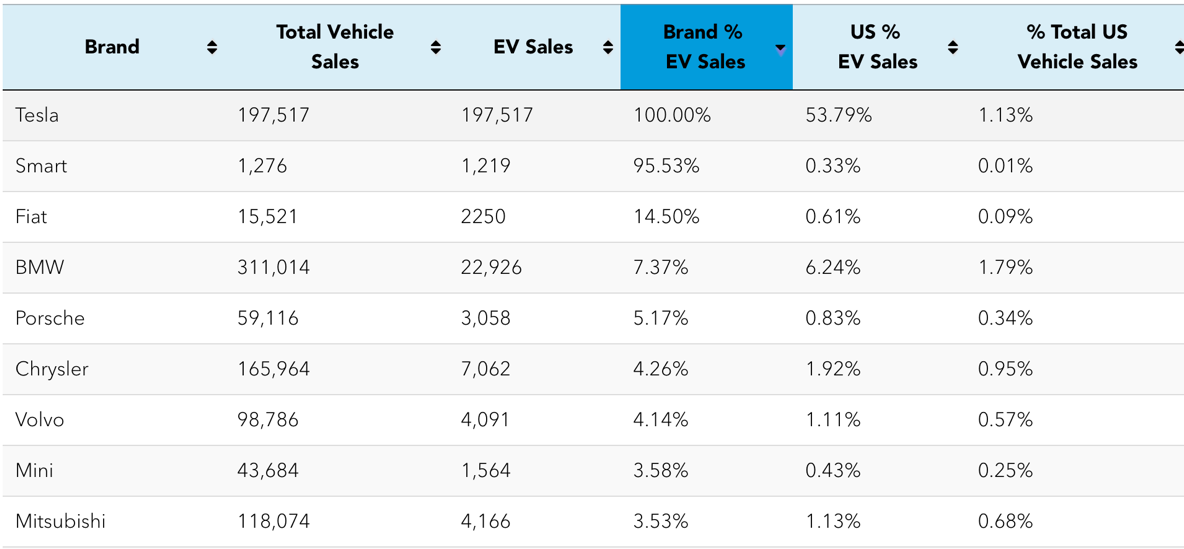
Social Factors
There is a steady trend toward a greening society and a culture of adequate consumption, and the Tesla, Inc. product fits well in this sense of eco-friendly vehicles (Söderholm, 2020). Global demand for EV batteries is projected to continue to grow by 2050 (Figure 1.2), creating a positive demand agenda for Tesla, Inc. (SRD, 2022). The trend toward digitalization of life is also noticeable, and Tesla, Inc. innovations, be they smart autopilot, regular software updates, and additional competitive features, are contributing to more robust demand.
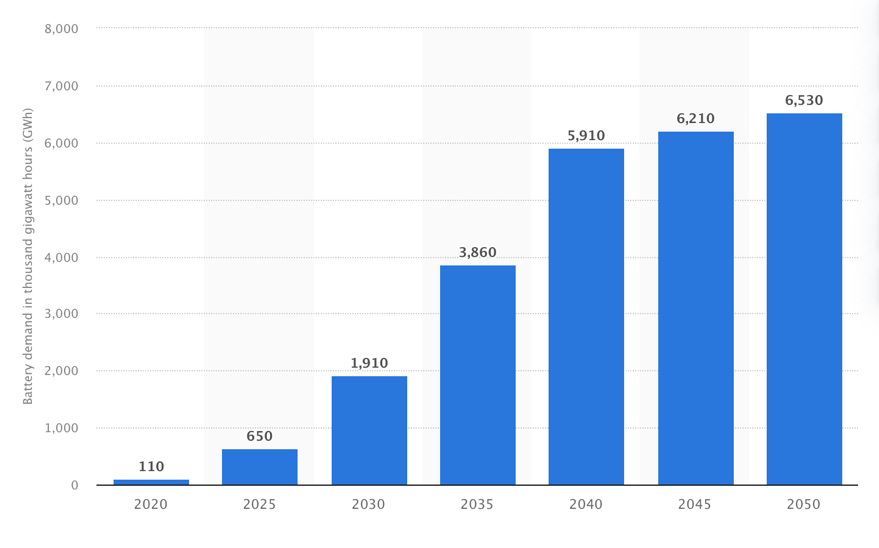
Technological Factors
The number of charging stations for EV is constantly increasing, which creates a comfortable environment for Tesla, Inc. to purchase the product as increased opportunities for EV arise each year (Figure 1.3). Fast charging technology is also developing, as well as solar-powered stations, potentially increasing demand and creating growth opportunities for Tesla, Inc.
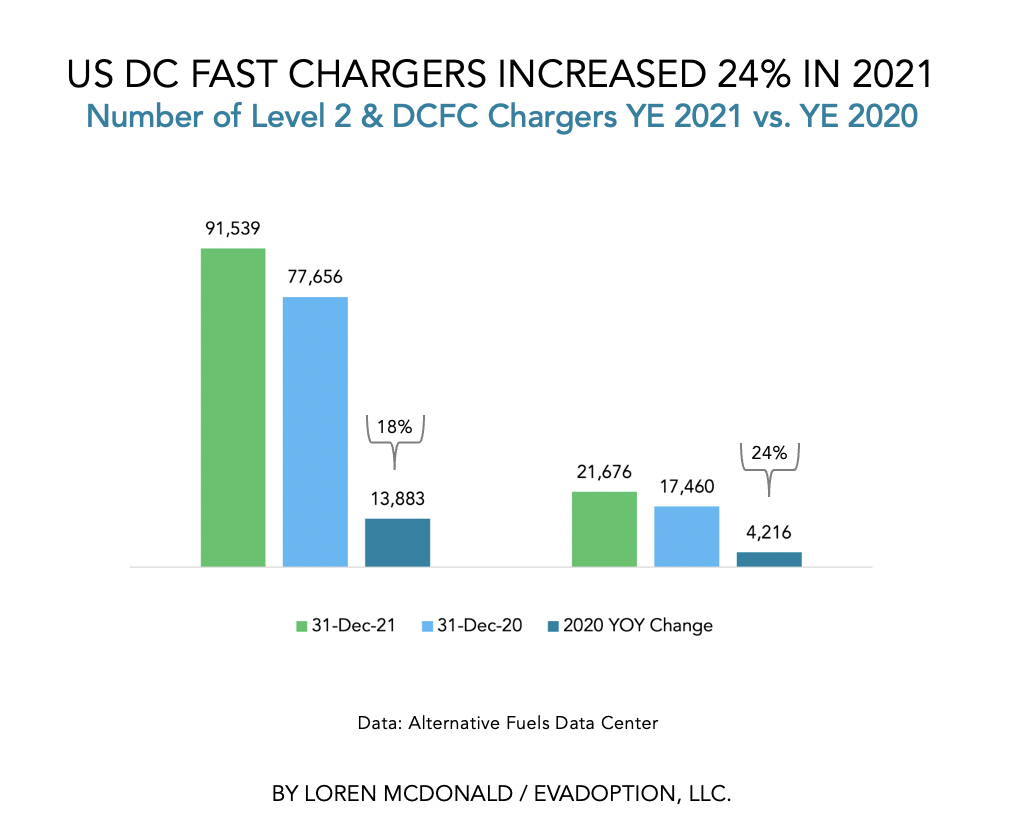
Legal Factors
The original U.S. company is expanding into foreign markets over time, so Tesla, Inc. must comply with regulations and laws in other countries. Even within the U.S., not all states are legally allowed to fully utilize the company’s product, as autopilots are still not permitted (AutoInsurance, 2022). The company also often faces class action lawsuits based on racial and gender discrimination in corporate practices (Wiessner and Hals, 2022).
Environmental Factors
Although the Tesla, Inc. product is considered more environmentally friendly than classic passenger cars, there is a common belief that this is not the case (Widota, 2019). Incorrectly recyclable batteries threaten the environment, and if the manufacturer fails to ensure this, it is subject to fines in some states (EPA, 2022b). Tesla, Inc. has switched to clean solar energy panels (Figure 1.4) and openly states its commitment to environmental safety.
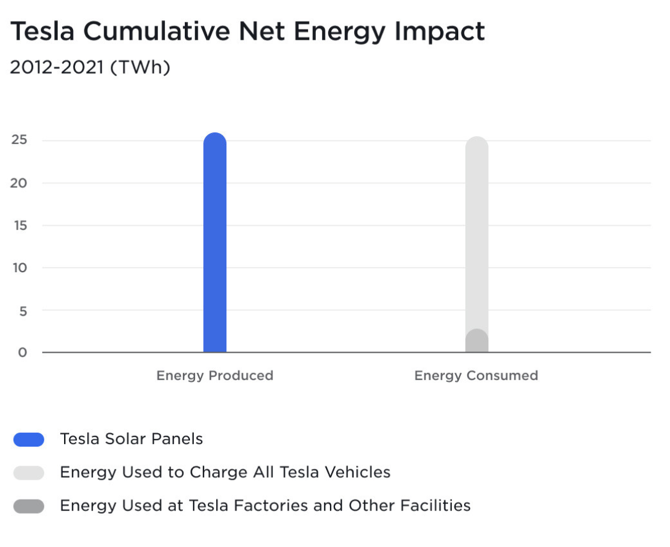
Five Forces
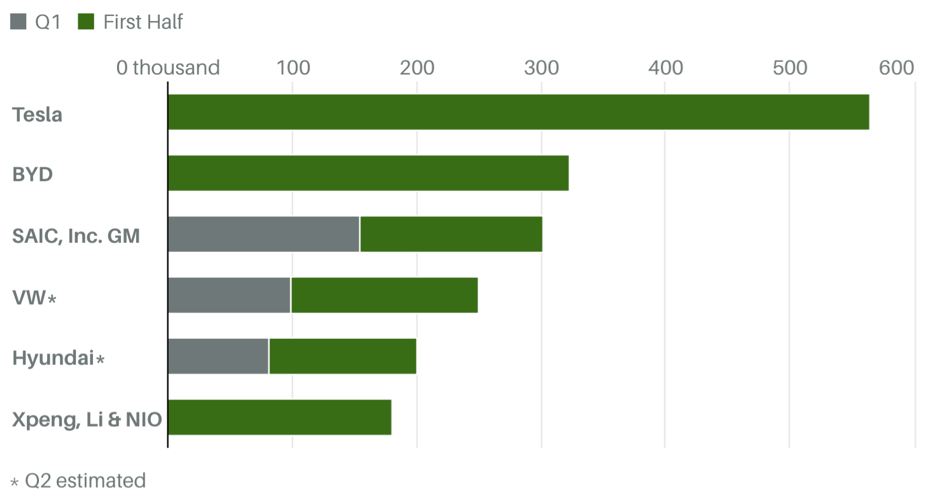
Based on the analysis of the Five Forces, this industry is attractive to Tesla, Inc.
Partial SWOT/Conclusion
Internal analysis, value chain model (vcm).
Based on VCM, the main reasons customers continue to buy from Tesla, Inc. are effective marketing, sustainability, and personalization of operations. Table 2.2 summarizes distinctive and conventional operations: it is the distinctive features that create high brand value and lead to higher profits over the past fourteen years (Figure 2.1).
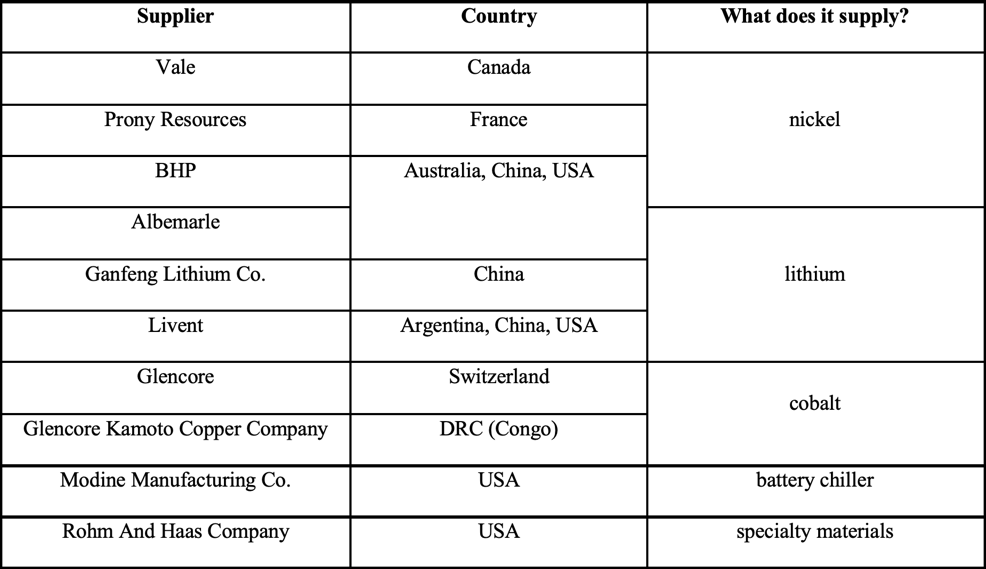
Tesla, Inc. is a valuable company because it has become one of the few companies that have surpassed a $1 billion capitalization and is also the leader in brand recognition in the EV industry (Thomas, 2021; Garsten, 2019). Musk’s impulsive management coupled with high customer loyalty to management and a developed customer community support high brand value.
Tesla, Inc. is not the only player in the EV industry (Figure 1.6) but combined with a mature community and aligned marketing that supports custom sales, Tesla, Inc. should be considered a rare brand in the industry.
Inimitability
Tesla, Inc. products, not so much the cars as the service and technology, are inimitable at the moment because the synthesis of personalization, innovation, and a largely positive customer experience for luxury EVs has not yet been surpassed. While the cars themselves can be replicated, Tesla, Inc.’s strong advantage lies in the accompanying service the company gives the customer.
Organization
Tesla, Inc. has a well-established supply chain (Figure 2.2) and is also actively investing in creating gigafactories in the United States. The company has established a well-developed supplier system (Table 2.1) and demonstrates efficient work on customer demand. Therefore, Tesla, Inc. should be viewed as a highly organized brand.

Conclusion of the Internal Analysis
Tesla, Inc. has a central competitive advantage through valuable service and market positioning as a predominantly technology company rather than an automotive company, which qualitatively sets Tesla, Inc. apart from its competitors. However, despite the current advantages, it is not unlikely that major competitors will be able to mimic the company’s successful model and reach more consumer segments, causing Tesla, Inc. to instantly lose key advantages. Below is a partial SWOT analysis to identify the key strengths and weaknesses of the company in the context of internal analysis. It follows from the SWOT that although the Tesla, Inc. has substantial competitive advantages, it cannot remain an absolute industry leader without effectively addressing its limitations.
Business Strategy and Model
Porter’s generic strategy.
The current key profit strategy at Tesla, Inc. is broad differentiation, in which the company actively invests in R&D and quality customer service to achieve a competitive advantage in the EV industry. Differentiation also creates secondary products — charging stations, unique technology, next-generation batteries — that encourage users to purchase the core products (Saxena and Vibhandik, 2021).
Bowman’s Strategy Clock
Bowman’s Strategy Clock (Figure 3.1) shows that Tesla, Inc.’s strategy is to create a moderately priced product with a quality competitive edge. Tesla, Inc. is focusing on wealthy customers for whom the car’s prestige is necessary because Tesla, Inc.’s EVs are not well suited for long out-of-town trips (Cristovao, 2021). Although Tesla, Inc. is trying to expand its potential customer base by lowering costs and increasing offerings, at the moment, its audience is focused and limited by technical and financial barriers. It is not profitable for the company to pursue low-price strategies because it may not justify the operating costs of creating a unique product with excellent service, which is the main competitive advantage of Tesla, Inc.
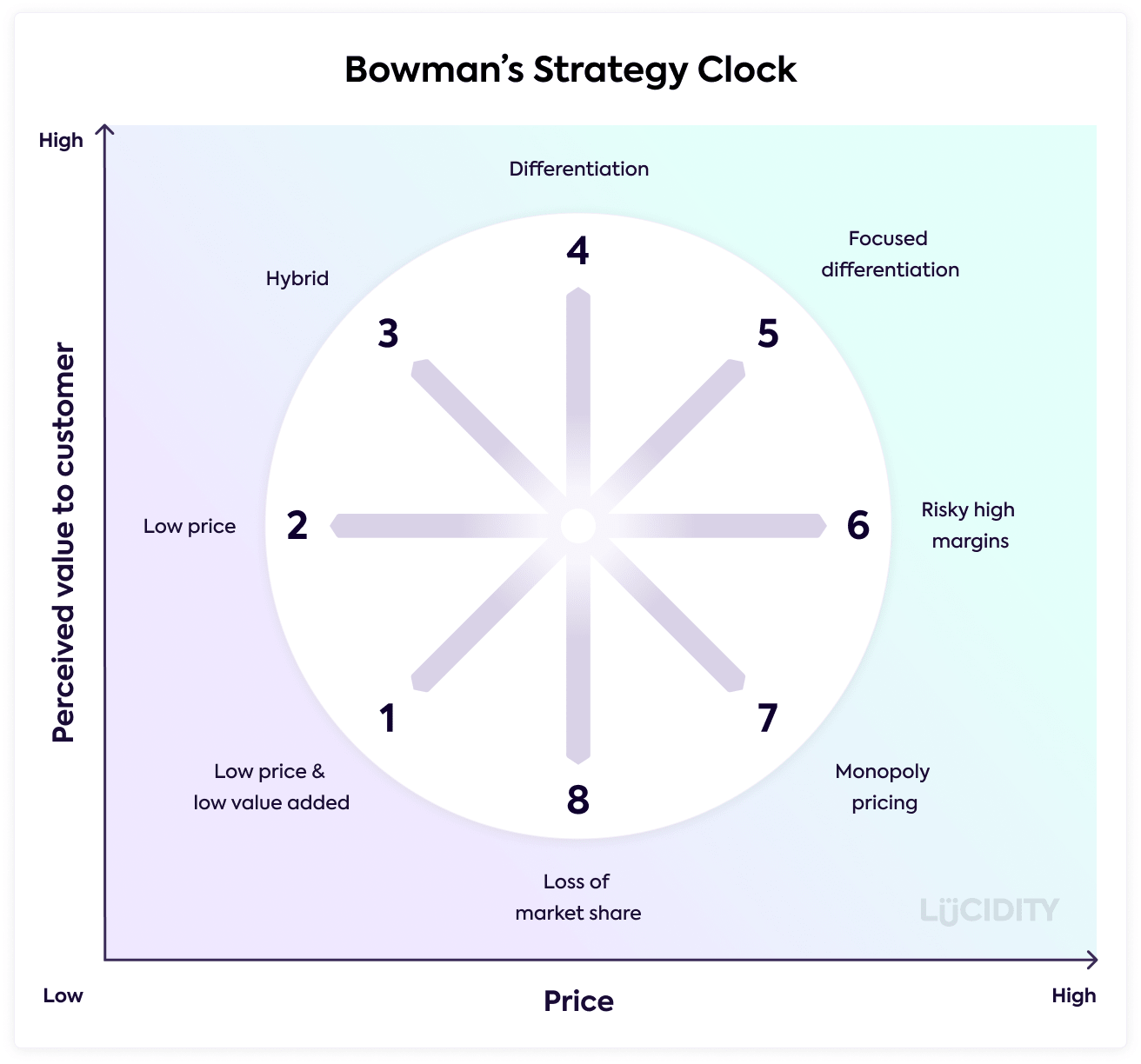
Business Model
The uniqueness of the Tesla, Inc. business model lies in creating a high-value end product and the perception of its uniqueness. Customers cannot buy the company’s EVs from dealerships or resellers, with the cars’ near-high price range deliberately limiting supply (Zucchi, 2022). Investing in secondary product development drives sales and popularity of Tesla, Inc. vehicles (Saxena and Vibhandik, 2021). For this reason, the company’s business model is based on broad differentiation, in which Tesla, Inc. has complete control over pricing and supply chain, as well as directly collected data on machine usage, which systematically maintains customer loyalty through developing tools.
Issues & Challenges and Strategic Options for Growth
Current issues & challenges.
Based on the earlier analysis of the external and internal environment, several critical problems faced by Tesla, Inc. at the moment can be identified. First, there is the problem of rush demand: since Tesla, Inc. supplies orders only when actually placed by the user, it cannot cover excess demand, which leads to a forced restriction of the customer base and, as a result, a shift of unprepared consumers to industry competitors. The problem of insufficient production capacity also creates constraints on orders already placed, as Tesla, Inc. may cause operational logistics to slow down in an effort to increase its reach among customers. As a result, the wait for a new EV from Tesla, Inc. can be several months, and announced new products can be continually postponed indefinitely (Kane, 2022).
Second is the excessive eccentricity of Elon Musk’s leadership, which has created an agenda in which rash decisions can lead to spikes in volatility. For example, in May 2019, Musk wrote on his Twitter profile that Tesla, Inc. stock was severely overvalued (Figure 4.1), causing herd investors to sell the securities actively — the share price dropped nearly 10 percent (Musk, 2020; Yahoo! Finance, 2022). The inability to control the virtual behavior of the CEO, or rather the high loyalty of private investors to his statements, has an ambiguous effect on the market value of Tesla, Inc. and can expectedly lead to failure, which creates problems for effective strategic planning.
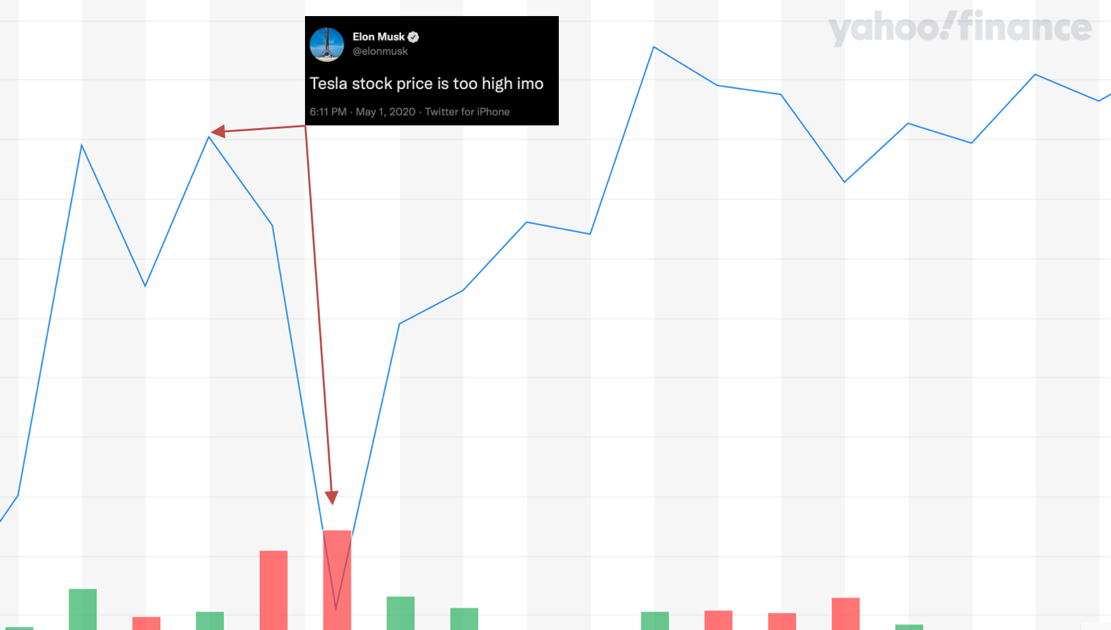
Third, the company faces the organizational costs of disrupted logistical communication in both the COVID-19 pandemic and geopolitical crises around the world, including the economic response to Russia’s invasion of Ukraine (Xinyi, Chen, and Bai, 2022). Any such crisis leads to an increase in the cost of EV production or secondary products, which in turn predictably affects the cost to the consumer as well. Tesla, Inc. has dozens of suppliers in Asian and European countries, so disruption of supply chains is an operational problem for the company.
Strategic Options
Based on the identified challenges that Tesla, Inc. is currently facing, several options for managing them should be proposed. Below is a demonstrated TOWS analysis based on preliminary statements gathered through SWOT — presented eight specific strategies that can be used by Tesla, Inc. to improve its competitive advantage and eliminate any threats. Among the most accessible is increasing the proportion of capital spent on R&D. To date, Tesla, Inc. is spending only 4.3% of total profits on R&D-related expenses (Table 1.2). Although this is the maximum among industry competitors, Tesla, Inc. should be viewed as a technology company to determine its place among the industry’s competitors. Table 4.1 compares R&D operating expenses as a total share of earnings for technology industry competitors over the past twelve months. As one can see, Tesla, Inc. is not a leader in this industry, so it has avenues for growth.
Table 4.1: R&D spending rates for large technology companies compared to Tesla, Inc. (obtained from Capital IQ).
Another development strategy is moving core production and storage to gigafactories in the U.S., which will significantly reduce the operational risks associated with global crises. Full-format assembly in the U.S., where most of Tesla, Inc.’s customers are represented, will allow the company to manage better supplies and control pricing, which will have a positive impact on the customer experience and create a competitive advantage for Tesla, Inc. (AMR, 2022). Another critical strategy for commercial development is to take control of Musk’s impulsive leadership. It is recognized that his behavior directly affects the market value and reputational appeal of Tesla, Inc., but at the same time, it is also recognized that abandoning such behavior can have disruptive long-term consequences. For this reason, Musk’s controlled conduct with respect to Tesla, Inc. is effective, dictated by the decisions of the company’s board of directors and lawyers, to avoid adverse effects on the brand but to maintain audience interest in Tesla, Inc.
Increasing the share of investment in R&D
The first strategy chosen in the last step is to increase the share of spending as part of the total capital spent on innovation and research. Since the current level at Tesla, Inc. is higher than competitors in the EV industry but significantly lower than competitors in the technology industry, it is implied that the company can demonstrate growth in this parameter. From an Appropriateness perspective, this strategy seems highly acceptable, as it aims not only to grow the brand’s competitive advantage but also to increase the loyalty of innovation-prone customers. Tesla, Inc. is already strongly associated in consumer perception with technology, so this bar cannot be lowered but has positive opportunities to increase further (DeBord, 2020). For comparison, Table 5.1 shows historical data on the share of operating expenses spent on R&D — it is clearly visible that the company this value shows a generally downward trend for the last ten years, which means Tesla, Inc. is gradually moving away from a commitment to innovation, which has negative consequences for customer loyalty. It is for this reason that this strategy is Acceptable, as a gradual increase in this indicator, expressed in the development of modern technologies and tools for EV management, will be beneficial to both Tesla, Inc. and its customers. By investing in innovation, among other things, Tesla, Inc. will become more integrated into the technology industry, in which it will have to compete with new players (Apple, Google, Amazon), which means it will have access to an expanded customer base. However, if this strategy fails, when investments have been increased, but revolutionary innovations have not been provided, Tesla, Inc. risks losing its reputation and customers, which will affect profits, among other things. Finally, the strategy is entirely feasible because it affects the financial, tangible, and intangible resources the company already has.
Table 5.1: Share of R&D expenses in profit over time (obtained from Capital IQ).
Transferring Production to the U.S.
This strategy seems appropriate as tensions are gradually rising on the world stage due to pandemic and geopolitical conflicts, including between the countries with which Tesla, Inc. cooperates as suppliers. The aggravation of U.S.-China relations and Xi Jinping’s repressive policies toward local technology companies could cause severe damage to supply chains (Han, 2018). Therefore, the suitability of this strategy does not seem questionable and is consistent with growth objectives. The benefits of this strategy will prove to be long-term, as moving assembly and storage to the U.S. will allow Tesla, Inc. to manage supply chains and control pricing better, as well as reduce the production speed of new cars, which will have a positive impact on the current deficient demand management. The feasibility of this strategy is also proposed to be evaluated through a cost-benefit analysis to determine how long this project is expected to take to show break-even. On the contrary, failure of the strategy would be highly critical, as it would result in the effects of lost profits combined with needlessly wasted resources to create new gigafactories as well as deteriorating profitable relationships with current suppliers. For this reason, Tesla, Inc. management should approach the implementation of the strategy with extreme caution. The feasibility of the strategy also seems problematic since it requires significant resources, most of which are not at the disposal of Tesla, Inc. Acquiring new territories, rearranging supply chains, and hiring employees are major cost items for this strategy.
Controlling Impulsive CEO Behavior
The third proposed strategy is to curb Elon Musk’s impulsive behavior in order to manage strategic planning and minimize the adverse effects, as was the case in May 2020. However, to maintain customer interest in the brand, it is not recommended to abandon such management entirely but rather to create a pseudo-impulsive behavior in which Musk’s actions appear to be aligned with the board of directors and only benefit Tesla, Inc. The strategy seems appropriate because it is consistent with the long-term growth goals of the company, as well as maximizing the effects of Tesla, Inc.’s managerial strengths. In terms of acceptability, with proper alignment at board levels, stakeholder interests are expected to be taken into account while focusing on the ultimate goal of increasing the company’s market value. Failure of this strategy would be critical, as it could lead not only to a public conflict between the board and Musk and a potential change of CEO but also to severe reputational damage. The feasibility of this strategy does not seem complex, as it does not require any material resources, but it does require a negotiation process and agreement on further public management practices.
Thus, based on the SAF analysis, the optimal strategy for further development of Tesla, Inc. is to increase the share of R&D expenditures in the context of the company’s overall earnings. The expected benefits from this strategy exceed the benefits of other recommendations, and the risks of failure are not so significant. In addition, Tesla, Inc. does not need to implement new resources and tools to implement the strategy but must review current financial policies. The essential resources and processes that Tesla, Inc. will need to achieve the positive effects of the strategy are budget restructuring, opening new labs, and hiring engineers.
Tesla, Inc. currently remains the global leader in the EV industry but increasing competition in both global and niche markets could cause this position to deteriorate. The analysis showed that Tesla, Inc. is bound by severe constraints, whether it be crisis logistics issues, uncontrollable CEO behavior, and poor demand management. The technological sophistication of major competitors continues to grow, and more companies are beginning to develop EV devices. For this reason, Tesla, Inc. needs to consider strategies that will leverage the company’s strengths to achieve positive results. According to the SAF analysis, the most acceptable and feasible strategy was to increase the company’s share of R&D investment, which is currently only 4.3% of earnings and has shown a downward trend over the past ten years. This strategy guarantees success because it aims to intensify the critical competitive advantage of the brand and increase customer loyalty.
Reference List
Al Root (2022) Tesla still tops the list of battery-EV makers. Here’s the top 5 .
AMR (2022) Tesla owner demographics: income, age, gender and more .
AutoInsurance (2022) Which states allow self-driving cars?
Bauer, H., et al. (2020) How the semiconductor industry can emerge stronger after the COVID-19 crisis .
BAW (2020) Tesla supply chain management, what happened? Web.
Carlier, M. (2022a) Plug-in electric vehicle sales market share by producer 2021 .
Carlier, M. (2022b) Tesla’s revenue 2008-2021 .
Collins, J. (2018) Elon Musk’s increasingly erratic behavior comes at a price for Tesla shareholders .
Crider, J. (2022) Tesla’s 6 factories are a new phase of its future .
Cristovao, N. (2021) What to do with your Tesla when going on vacation or storing it for longer periods of time .
DeBord, M. (2020) Tesla is doing something we haven’t seen since the early 20th century — rapidly building up a new industry. Here’s how .
EPA (2022a) Federal tax credits for new all-electric and plug-in hybrid vehicles .
EPA (2022b) Criminal Provisions of the Resource Conservation and Recovery Act (RCRA) .
EvaDoption (2021) EV charging statistics .
EvaDoption (2022) US EV sales percentages of total vehicle sales by brand .
FBI (2022) The U.S. electric vehicle market is projected to grow from $28.24 billion in 2021 to $137.43 billion in 2028 at a CAGR of 25.4% in forecast period, 2021-2028 .
Feiner, L. (2022) Musk says Tesla can lower car prices if inflation ‘calms down ’ .
Garsten, E. (2019) Tesla is an EV brand awareness juggernaut compared to competition .
Grandoni, D. and Dennis, B. (2021) Biden calls for half of new cars to be electric or plug-in hybrids by 2030 .
Han, H (2018) ‘Legal governance of NGOs in China under Xi Jinping: reinforcing divide and rule’, Asian Journal of Political Science , 26(3), pp. 390-409.
Jenson, L. (2022) Can you negotiate with Tesla?
Kane, M. (2022) Tesla’s market share keeps growing and growing .
Kane, M. (2022) US: survey reveals how long customers have waited for Tesla Model 3/Y .
Keesee, P. (2022) How many Tesla stores are there around the world? Web.
Klender, J. (2020) Tesla to build one new Service Center per week in 2021 .
Lambert, F. (2022) Tesla releases list of battery material suppliers, confirms long-term nickel deal with Vale .
Liang, J. (2022) A case study of marketing at Tesla based on the 4V theory .
Lucidity (2021) Introduction to Bowman’s Strategy Clock .
Musk, E. (2020) Tesla stock price is too high IMO.
Reddit (2021) Anyone else experiencing this lately? Autopilot will not give its regular blue flashing warning before the final red warning to put your hands on the wheel. My hands are on the wheel and the red alert is flashing every few seconds driving me crazy lmao .
Saxena, N. and Vibhandik, S. (2021) ‘Tesla’s competitive strategies and emerging markets challenges’, IUP Journal of Brand Management, 18(3), pp. 57-72.
Siddiqui, F. (2021) The government helped Tesla conquer electric cars. Now it’s helping Detroit, and Elon Musk isn’t happy .
Söderholm, P. (2020) ‘The green economy transition: the challenges of technological change for sustainability’, Sustainable Earth , 3(1), pp. 1-11.
SRD (2022) Forecasted electric vehicle battery demand worldwide 2020-2050 .
Tesla (2022a) Environment .
Tesla (2022b) Essentials | Model S. Web.
Tesla (2022c) Form 10-K .
Tesla (2022d) About Tesla .
Thomas, D. (2021) Tesla surpasses $1 trillion valuation after Hertz order .
US BLS (2022) Economy at a glance .
Walker, D. (2021) Industrial robots vs humans in manufacturing at Tesla . Web.
Widota, A. (2019) ‘The Tesla in the world of signs-between good and evil’, Scientific Papers of Silesian University of Technology Organization and Management Series , 35, pp. 223-234.
Wiessner, D. and Hals, T. (2022) Explainer: Do claims against Musk raise a legal issue for his companies and Twitter deal?
Xinyi, L., Chen, Z. and Bai, C. (2022) Case study research in Tesla (China) marketing strategy application during COVID-19 .
Yahoo! Finance (2022) Tesla, Inc. (TSLA) .
Zucchi, K. (2022) What Makes Tesla’s Business Model Different?
- Tesla, Inc. is currently the only company in the United States in the industry that is not unionized (Siddiqui, 2021).
- Biden’s goal is to eliminate internal combustion engine cars by 2030 (Grandoni and Dennis, 2021).
Cite this paper
- Chicago (N-B)
- Chicago (A-D)
StudyCorgi. (2023, July 27). The Tesla Inc. Strategic Analysis. https://studycorgi.com/the-tesla-inc-strategic-analysis/
"The Tesla Inc. Strategic Analysis." StudyCorgi , 27 July 2023, studycorgi.com/the-tesla-inc-strategic-analysis/.
StudyCorgi . (2023) 'The Tesla Inc. Strategic Analysis'. 27 July.
1. StudyCorgi . "The Tesla Inc. Strategic Analysis." July 27, 2023. https://studycorgi.com/the-tesla-inc-strategic-analysis/.
Bibliography
StudyCorgi . "The Tesla Inc. Strategic Analysis." July 27, 2023. https://studycorgi.com/the-tesla-inc-strategic-analysis/.
StudyCorgi . 2023. "The Tesla Inc. Strategic Analysis." July 27, 2023. https://studycorgi.com/the-tesla-inc-strategic-analysis/.
This paper, “The Tesla Inc. Strategic Analysis”, was written and voluntary submitted to our free essay database by a straight-A student. Please ensure you properly reference the paper if you're using it to write your assignment.
Before publication, the StudyCorgi editorial team proofread and checked the paper to make sure it meets the highest standards in terms of grammar, punctuation, style, fact accuracy, copyright issues, and inclusive language. Last updated: July 27, 2023 .
If you are the author of this paper and no longer wish to have it published on StudyCorgi, request the removal . Please use the “ Donate your paper ” form to submit an essay.
- Link to facebook
- Link to linkedin
- Link to twitter
- Link to youtube
- Writing Tips
How to Write a Perfect Analytical Paragraph

- 8-minute read
- 30th January 2023
If you are looking up how to write an analytical paragraph, you are most likely writing an argumentative or analytical essay. Analytical essays are similar to other essays, such as descriptive essays, in that you have a central idea, organize supporting ideas into body paragraphs, and make conclusions.
However, analytical essays differ from other essays because the writer must go further. They require the writer to interpret and analyze a given text or information using evidence to support their central idea or thesis statement. This analysis takes place in analytical paragraphs, or body paragraphs, if you are writing an analytical essay .
In this article, you’ll learn the components of a perfect analytical paragraph: the topic sentence, evidence, analysis, and conclusion. Keep reading to learn more.
What Is an Analytical Paragraph?
An analytical paragraph is a paragraph that breaks down a piece of literature, an idea, or a concept into smaller parts and analyzes each part to understand the whole. Being able to write an effective and successful analytical paragraph reflects a writer’s critical thinking and organizational writing skills. All in all, like any other type of writing, writing an analytical paragraph requires skill and practice.
Write the Topic Sentence
A topic sentence is usually the first, or sometimes second, sentence at the beginning of anybody paragraph. Your topic sentence should contain one main idea related to the thesis statement . If it is not related to your thesis statement, then you are likely off topic.
Pro Tip: If your topic sentence is the second sentence of your paragraph, then your first sentence should be a transitional sentence .
Let’s look at a thesis statement and some topic sentences to get a better idea.
Topic: Examine and analyze the marriages in George Eliot’s Middlemarch .
Thesis Statement: Eliot uses three different marriages to give depth to everyday people and show the reader the struggles of marriage within the nineteenth century’s societal standards of submissive roles, class range, and financial status.
Topic Sentence 1: Lydgate and Rosamond had a terrible marriage in Middlemarch , like all other marriages during this time.
This topic sentence is not effective because it is not specific enough and does not directly relate to the thesis statement. It does not mention how their “terrible” marriage is related to submissive roles, class range, or financial status. Additionally, the overly generalized language of “all” marriages being terrible marriages during this time is a weak argument.
Topic Sentence 2: Financial matters play a huge role in the Lydgate and Rosamond marriage, as Lydgate has no money and Rosamond is a big spender.
This topic sentence is effective because it directly supports the thesis statement. It is focused on the financial status of this marriage.
Provide Evidence
The type of evidence you use to support your topic sentence will largely depend on the topic of your analytical essay. For example, if you are writing an essay related to a work of literature, you will need to provide direct quotes, paraphrasing, specific details, or a summary from the work to support your main idea. If your topic is related to analyzing data, then you may use figures, statistics, or charts and graph evidence to support your topic sentence.
Regardless of what type of evidence you provide, it must be appropriate and directly relate to and support your topic sentence.
For example, if we take the above thesis and topic sentence, we might select direct quotes, paraphrases, or summaries from the novel Middlemarch that depict the marriage’s financial stress.
Pro Tip: When using direct quotes, make sure you always provide an in-text citation and use correct punctuation to ensure your essay is neat and clean.
Find this useful?
Subscribe to our newsletter and get writing tips from our editors straight to your inbox.
Once you have provided evidence, you should analyze it to illustrate its significance and how it relates to the topic sentence. In your analysis, you can discuss how an author uses certain literary devices to emphasize character traits, themes, patterns, and connections in a literary work.
Be sure that your analysis always connects to the topic sentence/main idea of the paragraph. Avoid introducing new ideas in this section. Save those for later paragraphs or consider creating a new one to explore and analyze the new point.
Conclude Your Paragraph
When closing an analytical paragraph, you can consider doing two things:
● Briefly emphasize the main point your reader should take away after having read the paragraph.
● Begin a transition if the analysis continues into the next paragraph. (This strategy may be more suitable for longer, more in-depth analytical essays).
Using the above example topic sentence, we might conclude the paragraph as follows:
Notice how this concluding statement not only emphasizes the main points from the paragraph but also ties back into the thesis statement.
Writing Tips For Analytical Paragraphs
Leave out first person language.
Avoid using language such as “in my opinion,” “from my perspective,” or “I think.” While the analysis is your interpretation of a text or information, you should rely on and focus on using evidence to support your ideas. Overall, you should aim to maintain an objective tone .
Instead of saying “I think Rosamond is manipulative,” you should use evidence from the text to show that she was manipulative. For example, “Rosamond shows a pattern of manipulation throughout Middlemarch , specifically toward her husband. For instance, she says, ‘…’”
Do Writing Exercises
When writing, especially in the early drafts of an essay, it is typical to find the main idea of a paragraph at the end. This is a natural course for our thinking process. However, the main idea should be presented as your topic sentence at the beginning of this paragraph. Additionally, most students leave this main idea at the end because they do not identify it as the main idea.
To overcome this dilemma, try a looping prewriting exercise . In this exercise, you write continuously for a designated time (maybe 10 minutes, your choice). At the end of that time, read over what you’ve written and circle the main idea of the text (this is usually at the end). In the next cycle, you start with this main idea at the beginning and further examine and analyze it.
This is a wonderful exercise to help you pick out main ideas and delve deeper into your analysis.
Get Feedback
If you are a student, there are several options to get feedback for free. Ask a friend to read your essay. Go to your writing center to get feedback and help with your writing. Go to your professor’s office hours with your writing or questions to get detailed advice. More often than not, they are happy to see you take advantage of their expertise.
As a working professional, writer, or author, you can look to fellow authors or bookish friends to read your work. You can find free beta readers online from sites such as Goodreads to get feedback from your target audience. You can also find writing groups on social media platforms.
Proofread Your Work
It can be easy to finish writing an essay and think “Finally, I’m done!” Unfortunately, that is only half the process. Be sure to always read and reread your writing before hitting submit. Check for stray commas, spelling errors, or awkward sentences to make your main ideas and hard work shine. Learn about 6 Quick and Easy Tips for Proofreading you can do at home.
Writing an analytical paragraph doesn’t have to be stressful. Be sure to include a topic sentence at the beginning of your paragraph that connects to the thesis statement. Provide a variety of evidence to support your main idea, analyze the text by highlighting literary devices used, themes, and patterns, and end with a brief concluding statement.
If you need more help with writing analysis, descriptive essays, or any other type of essay, then Proofed is here to help. Try our free trial today!
What Is a Topic Sentence?
A topic sentence goes at the beginning of a body paragraph and clearly states the main idea of the paragraph.

How Do I Organize an Analytical Paragraph?
An analytical paragraph has four components: topic sentence, evidence, analysis, and conclusion. The topic sentence is the most important part of any body paragraph because it establishes the main idea of the paragraph and relates to the thesis statement.
What Makes a Good Analytical Paragraph?
A good analytical paragraph has a clear topic sentence, strong evidence, and a thorough analysis that reflects the writer’s critical thinking and writing skills. It should conclude by emphasizing the main idea of the paragraph and how it supports the essay overall.
Share this article:
Post A New Comment
Got content that needs a quick turnaround? Let us polish your work. Explore our editorial business services.
2-minute read
How to Cite the CDC in APA
If you’re writing about health issues, you might need to reference the Centers for Disease...
5-minute read
Six Product Description Generator Tools for Your Product Copy
Introduction If you’re involved with ecommerce, you’re likely familiar with the often painstaking process of...
3-minute read
What Is a Content Editor?
Are you interested in learning more about the role of a content editor and the...
4-minute read
The Benefits of Using an Online Proofreading Service
Proofreading is important to ensure your writing is clear and concise for your readers. Whether...
6 Online AI Presentation Maker Tools
Creating presentations can be time-consuming and frustrating. Trying to construct a visually appealing and informative...
What Is Market Research?
No matter your industry, conducting market research helps you keep up to date with shifting...

Make sure your writing is the best it can be with our expert English proofreading and editing.
Strategic Analysis Tools Essays
Business strategy: critically relate innovation and strategy, popular essay topics.
- American Dream
- Artificial Intelligence
- Black Lives Matter
- Bullying Essay
- Career Goals Essay
- Causes of the Civil War
- Child Abusing
- Civil Rights Movement
- Community Service
- Cultural Identity
- Cyber Bullying
- Death Penalty
- Depression Essay
- Domestic Violence
- Freedom of Speech
- Global Warming
- Gun Control
- Human Trafficking
- I Believe Essay
- Immigration
- Importance of Education
- Israel and Palestine Conflict
- Leadership Essay
- Legalizing Marijuanas
- Mental Health
- National Honor Society
- Police Brutality
- Pollution Essay
- Racism Essay
- Romeo and Juliet
- Same Sex Marriages
- Social Media
- The Great Gatsby
- The Yellow Wallpaper
- Time Management
- To Kill a Mockingbird
- Violent Video Games
- What Makes You Unique
- Why I Want to Be a Nurse
- Send us an e-mail
- Call to +1 844 889-9952
Strategic Analysis and Operational Considerations
Competition is one of the determining factors in the allocation of resources within the health industry. In the medical services market, it can be defined as a process of interaction between patients, medical institutions, and insurance companies aimed at achieving everyone’s target needs. An example of implementing the strategic analysis in the real world scenario is a new for-profit 50-bed acute care hospital. St. Anthony Medical Center is slated to open in the next eight months, offering a full complement of services. Thus, there is a need to conduct a strategic analysis that allows managers to evaluate the healthcare institution’s activities. As a result of the research, the company receives the required information to develop a long-term competitive strategy. An adequately prepared strategic analysis of an enterprise allows it to make informed management decisions and reduces the risks affecting its position in the industry.
Understanding the Environment
The growth of global competition leads to the need for reengineering business processes to ensure a medical organization’s efficiency. The point of strategic planning is that it combines the main objectives. The analysis can develop policies and related actions based on anticipating changes in the environment, being useful for allocating medical organizations’ resources in a particular and relevant way. In situations where the organization’s capacity does not match the challenge of capturing new opportunities and does not provide risk aversion, healthcare leaders should concentrate personnel’s focus on new plans (Ginter et al., 2018). Therefore, such approaches can be successfully implemented through strategic planning.
Since medical services are considered as any other product that can be bought or sold according to the market’s classical laws, the US healthcare system is an example of a typical business model. The medical sector is represented by developed private medical institutions and commercial medical insurance systems. Due to the intense competition, conditions are created to improve quality, adopt innovations and technologies, and reject economically ineffective planning strategies (Westra et al., 2017). These circumstances define the positive aspects of the healthcare market model. A medical institution’s competitiveness can be assessed according to several areas such as external competition, staffing, stakeholders and organizational capacity.
External Competition
The most significant impact on the competitive advantages of medical institutions arises from uncontrollable factors. For example, this might be the outstripping growth in the average cost of medicine compared to this growth in other spheres of the economy (Westra et al., 2017). Such conditions also include the monopoly of clinics and pharmaceutical transnationals and the medical education system. Currently, effective management is achievable only if adapted to constant external environment changes (Westra et al., 2017). It is impossible to stop the growth in the costs of medical care. Still, it is reasonable to find other reserves for the rational use of resources, new forms of organizational structures, and adequate marketing.
Increase the employee’s responsibility for the quality of the work performed in the treatment and diagnostic process framework. The medical services provided principally depend on improving the personnel training and retraining system (Westra et al., 2017). For competitive advantage, strategic planning should consider the work environment, which is created to stimulate each employee’s desire to master the knowledge of technological advances and raise their professional level (Ginter et al., 2018). Moreover, the introduction of new medical equipment requires a different approach to medical workers’ training, including universal practice in modern practice standards.
Stakeholders and Organizational Capacity
In the healthcare system, the acquisition of assistance, payment, and service provision are separated processes. As a result, the emergence of a multi-level stakeholder system increased organizational capacity standards (Westra et al., 2017). Corporate payers are represented by insurance companies and health maintenance organizations, creating funds and finance the provided medical assistance (Westra et al., 2017). Since stakeholders’ interests may not coincide, employers are interested in paying the minimum insurance payments. Patients need to receive quality care; medical institutions are engaged in making a profit and providing the maximum number of services that are not always required (Westra et al., 2017). Insurance companies tend to spend fewer amounts on patients’ treatment.
Thus, competition in the health industry constitutes the environment of relationships among production and consumption processes of medical services. It is performed within the framework of a specific civilized form of concurrence between medical workers to manage the patients’ target needs and their highest satisfaction level (Westra et al., 2017). The concept of competition indicates understanding a particular process and the function of relationships between subjects. It might lead to a significantly positive result that characterizes medical care quality for a good set of specifications established and accepted parameters.
Organizational Analysis
Strategic planning management should become the basis for adopting a medical organization’s leadership in the new conditions. It is necessary to include a comprehensive analysis of competition conditions to prevent a conflict of interest in the participants’ medical services market. It should consist of external conditions, such as state policy in health care, scientific development advances, and internal ones, for example, determining the price and quality of services and particular organizational issues (Ginter et al., 2018). For healthcare organizations’ strategic frameworks, it can be useful to determine strengths, weaknesses, opportunities, and threats regarding the external and internal environment. The favorable position is ensured by the availability of modern medical equipment, qualified medical personnel, raised salaries, and affordable prices combined with high-quality therapeutic services (Ginter et al., 2018). Weaknesses are determined as high costs of acquiring modernized medical equipment and a limited range of medical services compared to larger medical institutions.
Internal factors include opportunities and threats; the continued stable growth of the healthcare market, including in the context of economic crises, is beneficial for the hospital’s financial state in the long term. The upward trend of high demand for quality paid medical services will remain (Ginter et al., 2018). The key threat is the annual growth in the number of for-profit acute care hospitals. Consequently, the healthcare system’s competition is increased, and there are specific barriers to entering the medical market and rising costs for consumers.
Porter’s Five Forces of Competitive Position Analysis
Profound threat analysis requires the appliance of Porter’s five forces model. Concerning threats of new entrants, the medical services market should be classified as an imperfectly competitive market. A small number of sellers dominate, while high barriers limit new businesses’ entrance into the industry. The hospital needs to have an appropriate material and resource base and go through all the administrative approval stages (Ginter et al., 2018). Otherwise, it cannot count on high profits and dominant market positions.
The threat of substitute services is high due to numerous market actors. These are multiple healthcare organizations; competition within healthcare provides the importance of patients’ rights as consumers, including choosing a clinic and a physician (Ginter et al., 2018). Considering the bargaining power of customers, the clinic is motivated to compete for clients and strives for profitability by lowering costs and increasing public health services’ utility. Several factors affect the competitive environment, for example, the patient’s right to freely choose a doctor and ensure free access for patients to medical institutions and medical practices (Ginter et al., 2018). A healthcare facility depends on several provider groups, which is crucial when suppliers offer specialized products. For example, pharmaceutical companies that produce brand-name drugs have a more substantial influence on healthcare organizations and customers than pharmaceutical companies that manufacture generic or older medicines (Westra et al., 2017). Consequently, St. Anthony Medical Center should focus on providing a high-quality drug supply.
As long as the healthcare system is a market, it is crucial to promote marketing campaigns to increase popularity among citizens. Patients tend to choose to access the Internet via mobile devices (Ginter et al., 2018). Based on this, the hospital can develop a complete marketing strategy via creating mobile applications. Due to the abundance of offers and advertising, patients began to value the quality of medical services and their comfort (Ginter et al., 2018). The private and public strategy should focus on increasing healthcare provision quality to the consumer (Ginter et al., 2018). In this case, value is understood as the standard to which the patients’ needs and interests are met.
Internal and external environment analysis is needed to determine a medical organization’s behavior strategy and implement this strategy in life. It is essential to properly study the organization’s environment for the most effective management decisions necessary for successful performance. Thus, a medical company’s appropriate option to achieve effective long-term functioning and successful development is to pay increased attention to the strategic framework. This implies a comprehensive analysis, which can be produced using the above methods, giving a relatively objective picture of its competitive position. Taking into account this condition, the hospital guarantees the effectiveness of strategic and operational management decisions.
Ginter, P. M., Dnucan, W. J., & Swayne, L. E. (2018). The Strategic Management of Health Care Organizations (8th ed.). John Wiley & Sons.
Westra, D., Angeli, F., Carree, M., & Ruwaard, D. (2017). Understanding competition between healthcare providers: Introducing an intermediary inter-organizational perspective. Health Policy , 121 (2), 149-157. Web.
Cite this paper
Select style
- Chicago (A-D)
- Chicago (N-B)
BusinessEssay. (2022, November 23). Strategic Analysis and Operational Considerations. https://business-essay.com/strategic-analysis-and-operational-considerations/
"Strategic Analysis and Operational Considerations." BusinessEssay , 23 Nov. 2022, business-essay.com/strategic-analysis-and-operational-considerations/.
BusinessEssay . (2022) 'Strategic Analysis and Operational Considerations'. 23 November.
BusinessEssay . 2022. "Strategic Analysis and Operational Considerations." November 23, 2022. https://business-essay.com/strategic-analysis-and-operational-considerations/.
1. BusinessEssay . "Strategic Analysis and Operational Considerations." November 23, 2022. https://business-essay.com/strategic-analysis-and-operational-considerations/.
Bibliography
BusinessEssay . "Strategic Analysis and Operational Considerations." November 23, 2022. https://business-essay.com/strategic-analysis-and-operational-considerations/.
- Associated Brands Industries Limited (ABIL) Charles Chocolates
- Enhancing Nonprofit Executive and Staff Diversity and Inclusion
- The Coca-Cola Company: Strategic Plan Evaluation
- Alfred Chandler’s Theories and Their Application to Modern Business
- Strategic Investment Analysis of McLaren Group
- Applying Principles for Enterprises in the Non-Profit Sector
- Nike COVID-19 Response: Strategic Management in Action
- An Integrated Balanced Scorecard Strategic Planning Model for Nonprofit Organizations
- Boeing and Airbus Companies’ Balance Score Cards
- Researching of Porter’s Five Force Model
- +1520 221 7280
- [email protected]

- Application Essay Writing
- How to write a Book Review
- Case Study Writing
- College Essay
- Coursework Writing
- Dissertation Writing Assistance
- Dissertation Writing Service
strategic case analysis
- Posted on April 24, 2016
- (0) Comment
Topic: strategic case analysis
Order Description OUTLINE AND REQUIREMENTS
In this assignment, you will assume the role of management consultant, who has the role of
conducting a strategic case analysis of a large company, and providing the company with
recommendations for improved long-term performance.
You are required to conduct a strategic analysis of this business or organization. This
should involve external and internal environmental scanning, including PESTEL, Five-
forces analysis, Stakeholder analysis, internal strength-weakness and SWOT analysis.
Your assignment should include an analysis of the major problems or issues faced by the
company, and conclude with recommendations to assist the company in dealing with its
major strategic problems (or, if the company is currently successful, focus on the continued
improvement of the company in the longer term).
Recommended issues to discuss in the major assignment.
These are recommended issues only. You may combine some of these issues, leave
some out if they are not relevant, or add other issues if appropriate.
1. Executive summary (cover page, summarizing the main points of your
2. A brief description of the organization, including its name and the type of
3. An external analysis (at the industry/macro-environment levels). For
4. An internal analysis. For example:
5. A “Five-forces” analysis of the industry the organization is based in. Apply
6. How will the organization address the four generic building blocks of
strategic analysis, as below).
business (what products or services it provides), as well as the type of staff,
the number of staff, the number of branches etc.
a) Current and potential opportunities and how they may be
taken advantage of.
b) Current and potential threats and how they might be
overcome or minimized.
If relevant, discuss the impact of national culture and conditions on
the organization.
a) strengths and how they will be used ,
b) weaknesses, and, if possible, how they might be overcome or
this model to discuss how you can maximize the competitive advantage of
competitive advantage: efficiency, quality, innovation, and customer
responsiveness
7. Discuss the distinctive competencies of the organization.
8. Does the organization have a differentiation strategy Discuss.
9. If relevant, discuss any strategic alliances that may benefit your
10. Should the organization go global Why/why not If yes, how will this be
11. Based on the above, what are the major problems or potential problems the
12. Based on your analysis of the major problems or potential problems, what
organization.
organization should address
are your recommendations for the organization
Advertisement
Supported by
news analysis
Israel’s Strike on Iran: A Limited Attack but a Potentially Big Signal
Israel hit a strategic city with carefully measured force, but made the point that it could strike at a center of Iran’s nuclear program.
- Share full article

By David E. Sanger and Eric Schmitt
Reporting from Washington
For more than a decade, Israel has rehearsed, time and again, bombing and missile campaigns that would take out Iran’s nuclear production capability, much of it based around the city of Isfahan and the Natanz nuclear enrichment complex 75 miles to the north.
That is not what Prime Minister Benjamin Netanyahu’s war cabinet chose to do in the predawn hours of Friday, and in interviews, analysts and nuclear experts said the decision was telling.
So was the silence that followed. Israel said almost nothing about the limited strike, which appeared to do little damage in Iran. U.S. officials noted that the Iranian decision to downplay the explosions in Isfahan — and the suggestions by Iranian officials that Israel may not have been responsible — was a clear effort by the Islamic Revolutionary Guards Corps to avoid another round of escalation.
Inside the White House, officials asked the Pentagon, State Department and intelligence agencies to stay quiet about the operation, hoping to ease Iran’s efforts to calm the tensions in the region.
But in interviews, officials quickly added they worried that relations between Israel and Iran were now in a very different place than they had been just a week ago. The taboo against direct strikes on each other’s territory was now gone. If there is another round — a conflict over Iran’s nuclear advances, or another strike by Israel on Iranian military officers — both sides might feel more free to launch directly at the other.
Mr. Netanyahu was under competing pressures: President Biden was urging him to “take the win” after a largely ineffective aerial barrage launched by Iran last week, while hard-liners in Israel were urging him to strike back hard to re-establish deterrence after the first direct effort to strike Israel from Iranian territory in the 45 years since the Iranian revolution.
American officials say they recognized quickly that they could not talk Mr. Netanyahu out of some kind of visible response.
So the White House and the Pentagon urged what amounted to what one senior American official called a “signal, not a strike,” with minimal chance of casualties. But while it was a minimalist option, its long-term effects on the Revolutionary Guards and the teams of scientists who work on Iran’s nuclear program have the potential to be substantial. They could speed a movement to put more nuclear facilities deep underground, or to expand them to make it even harder for nuclear inspectors to understand where Iran is doing its most sensitive work.
And, American officials worry, that may accelerate the confrontation over the nuclear program itself, which has grown more and more opaque to inspectors over the past two years.
The signal sent by the decision to hit a conventional military target in Isfahan was clear: Israel demonstrated that it could pierce Isfahan’s layers of air defenses, many of them arrayed around key sites like the Isfahan uranium conversion facility.
That 25-year-old facility, relatively vulnerable to a strike, is Iran’s primary production line for converting its large stores of natural uranium into a gas — called UF6 — that can be fed into centrifuges to produce nuclear fuel, either for power production or nuclear weapons.
Israeli warplanes also fired missiles on Iran during the attack, suggesting that more advanced firepower was involved than initial reports had indicated.
It was not immediately clear what types of missiles were used, where they were fired from, whether any were intercepted by Iran’s defenses or where they landed. But just as the drones launched from under Iran’s nose sent a message about Israel’s capabilities, so did guided missiles from Israeli warplanes.
A senior American official, speaking on condition of anonymity to discuss sensitive intelligence assessments, said on Friday that Israel had notified the United States through multiple channels shortly before the attack. But unlike the alert Israel gave the administration moments before its warplanes struck the Iranian embassy complex in Damascus on April 1, the official said this latest attack was not unexpected given all the warnings Israel had issued during the week.
“While there has been no official claim of responsibility for the overnight attack against the military base in Isfahan, the message is clear: Iran’s attempt to unilaterally move the goal posts of war in the region will not be met with silence and inaction,” said Dana Stroul, the Pentagon’s former top Middle East policy official who is now at the Washington Institute for Near East Policy. “A state-on-state attack involving drones and missiles will be met with a response.”
“Yet last night’s strike was precise and limited,” Ms. Stroul added. “The message is that Iranian air defenses are entirely penetrable, and their forces cannot protect their military bases from external attack. But the damage was limited. If Iranian leaders decide that further escalation is not worth the risk of a much more lethal and expensive attack within their own territory, this escalation cycle can close.”
The longer-term effects are harder to predict. Vali Nasr, an Iran expert and former dean of the Johns Hopkins School of Advanced International Studies, noted recently that Iran would likely now be determined to move its weapons “closer to Israel,” and may face new pressure at home to openly seek a nuclear deterrent.
Iran has barred some, but not all, inspectors from the International Atomic Energy Agency, the world’s nuclear watchdog. It has enriched uranium to 60 percent purity, putting it just days or weeks from bomb-grade quality. And at the height of the conflict with Israel last weekend, some senior commanders talked publicly about Iran reconsidering its official position, which is that it would never seek a weapon.
Julian E. Barnes contributed reporting.
David E. Sanger covers the Biden administration and national security. He has been a Times journalist for more than four decades and has written several books on challenges to American national security. More about David E. Sanger
Eric Schmitt is a national security correspondent for The Times, focusing on U.S. military affairs and counterterrorism issues overseas, topics he has reported on for more than three decades. More about Eric Schmitt
- SUGGESTED TOPICS
- The Magazine
- Newsletters
- Managing Yourself
- Managing Teams
- Work-life Balance
- The Big Idea
- Data & Visuals
- Reading Lists
- Case Selections
- HBR Learning
- Topic Feeds
- Account Settings
- Email Preferences
6 Common Leadership Styles — and How to Decide Which to Use When
- Rebecca Knight

Being a great leader means recognizing that different circumstances call for different approaches.
Research suggests that the most effective leaders adapt their style to different circumstances — be it a change in setting, a shift in organizational dynamics, or a turn in the business cycle. But what if you feel like you’re not equipped to take on a new and different leadership style — let alone more than one? In this article, the author outlines the six leadership styles Daniel Goleman first introduced in his 2000 HBR article, “Leadership That Gets Results,” and explains when to use each one. The good news is that personality is not destiny. Even if you’re naturally introverted or you tend to be driven by data and analysis rather than emotion, you can still learn how to adapt different leadership styles to organize, motivate, and direct your team.
Much has been written about common leadership styles and how to identify the right style for you, whether it’s transactional or transformational, bureaucratic or laissez-faire. But according to Daniel Goleman, a psychologist best known for his work on emotional intelligence, “Being a great leader means recognizing that different circumstances may call for different approaches.”
- RK Rebecca Knight is a journalist who writes about all things related to the changing nature of careers and the workplace. Her essays and reported stories have been featured in The Boston Globe, Business Insider, The New York Times, BBC, and The Christian Science Monitor. She was shortlisted as a Reuters Institute Fellow at Oxford University in 2023. Earlier in her career, she spent a decade as an editor and reporter at the Financial Times in New York, London, and Boston.
Partner Center
- FanNation FanNation FanNation
- SI.COM SI.COM SI.COM
- SI Swimsuit SI Swimsuit SI Swimsuit
- SI Sportsbook SI Sportsbook SI Sportsbook
- SI Tickets SI Tickets SI Tickets
- SI Showcase SI Showcase SI Showcase
- SI Resorts SI Resorts SI Resorts
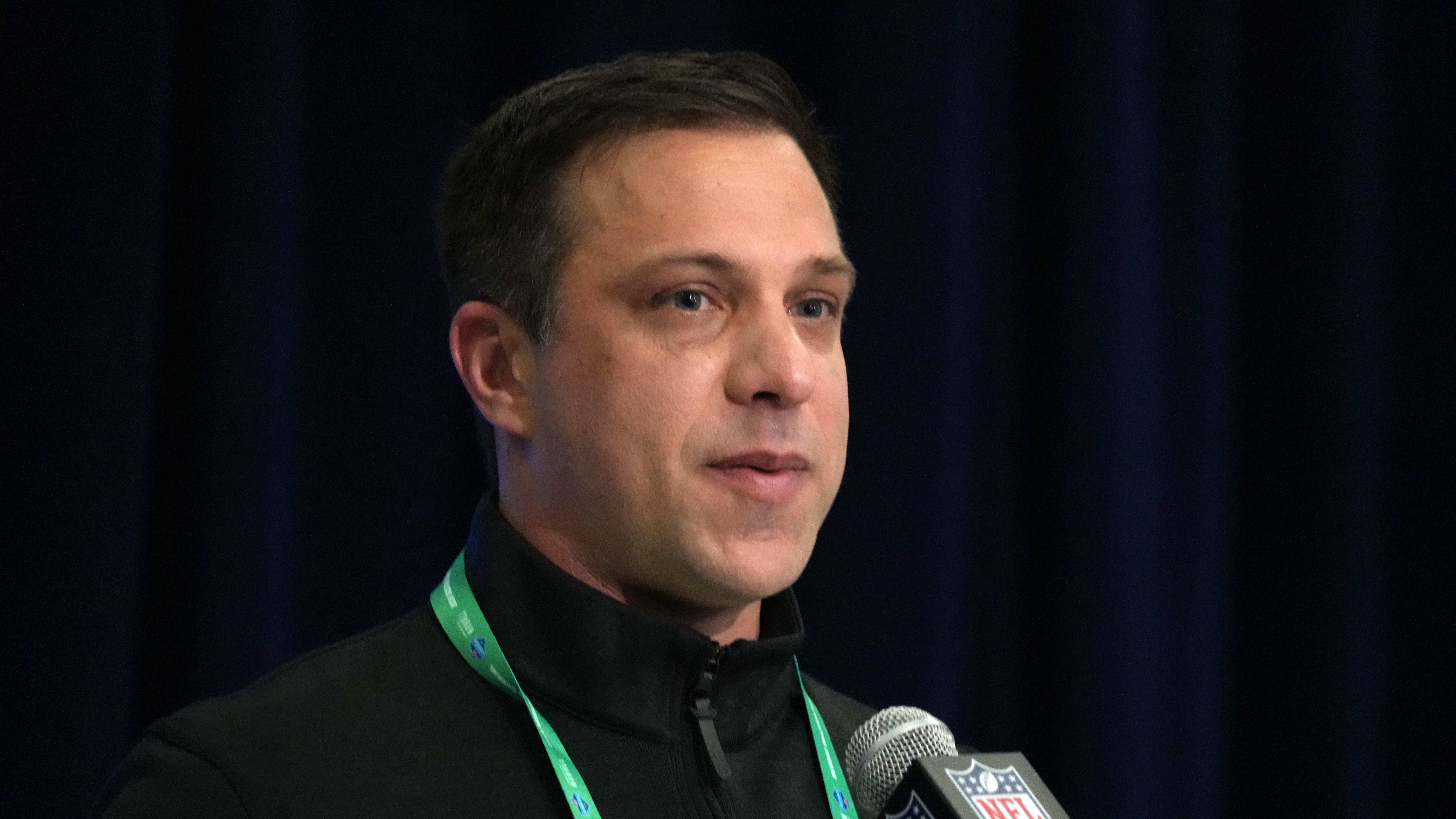
Brett Veach Talks Wanya Morris, Chiefs' Potential Draft Strategy at OT
Veach echoed some sentiments similar to Andy Reid on Wanya Morris, also hinting at how KC could attack the offensive tackle position in the draft.
- Author: Jordan Foote
In this story:
With the 2024 NFL Draft approaching, the Kansas City Chiefs will have opportunities to address remaining needs for the rest of the offseason. A position in question is left tackle, which is a possible selection with one of the team's three top 100 picks.
At the beginning of Kansas City's offseason program, head coach Andy Reid spoke about current projected starter Wanya Morris . Reid tipped his cap to the 2023 third-round pick for the job he's done, although he also alluded to a need for improvement. Reid stated there "will be competition," allowing the draft scenario to come into play again.
Speaking to the media in his annual pre-draft call, general manager Brett Veach did little to deviate from that path or messaging.
“I think we were really happy with Wanya’s development last year and think he showed some signs early on in OTAs that we were really excited about," Veach said. "He continued that growth and maturation process during training camp. Middle of the season he got an opportunity there, some good, some bad. I think Wanya would tell you this, I think if you look at his body of work last year, on one end you’re happy that he was able to come in at the pro level and be competitive, it wasn’t perfect but it also was solid play that I think is a good foundation to build and grow on.
"He has to come in here with the mindset that we’re going to look to bring in competition and he’s got to come in here and win that position, and I think it’s his job to come in and be prepared to win that position. I think it’s our job to go out there and find competition for that left tackle spot. Again, I think that there’s a lot of promise in there and there’s a lot of ability, but certainly I think it’s our job to bring in some competition there and make him earn that and work for it.”
As far as the draft is concerned, Veach mentioned the 35-40 pick range as a cutoff for possibly landing a premier prospect. It's safe to assume that barring a trade-up, the Chiefs won't be in play for top-tier tackles such as Joe Alt, Olu Fashanu, Troy Fautanu or Taliese Fuaga. J.C. Latham is less of a lock, albeit still a highly doubtful candidate to be available at the end of round one.
This is where the aforementioned range comes in. If Kansas City stands pat, it could be hoping for a slide for someone like Amarius Mims of Georgia. Additionally, the path may be there for one or more of Tyler Guyton, Jordan Morgan, Patrick Paul or Kingsley Suamataia to be on the board. Other players have solid cases for being selected in the draft's first couple of rounds, but this is the prime group for the Chiefs.
The timing of a hypothetical selection, in theory, represents a sliding scale of sorts for how to interpret potential competition for Morris. A first- or second-round pick should be viewed as a direct competitor for the 2024-25 starting left tackle job. Anything later leaves the door wide open for Morris to pick back up where he left off in Weeks 13-16 of last season.
To cap things off, Veach referenced Kansas City putting "a lot of stock" in positional versatility along the line. Morris, having played right tackle a lot in college before moving over for the Chiefs, is a great example. After an up-and-down first season in the league, the Oklahoma product's job is to stave off any challengers and earn the outright gig during OTAs, training camp and the preseason.
How big of a challenge will he face, though? That will be determined very soon.
Read More: Brett Veach Shares Thoughts on 2024 NFL Draft WR Class
Latest chiefs news.

Cowboys' Prescott Ranked Second-Best NFL QB? By Whom?!

Top-Paid Players at Every Position After NFL Free Agency

Chiefs’ Travis Kelce Unleashed His Best ‘Love Is Blind’ Impression, and Fans Loved It

Mailbag: Vikings’ Quarterback Target Must Warrant a Trade Up

Former Chiefs Safety Mike Edwards Signs With Bills
Strategic Management: Internal Analysis and SWOT Essay
Toyota Motor Corporation, the world leading car maker, has not been performing well over the recent past as it has been recalling some of its cars because of technical problems. This has been the company’s first car recall in 59 years and it led to an annual net loss (Takahashi, 2010).
However, the car maker was reported to be on the verge of making a 48% profit growth estimated at 310 billion yen (the equivalent of $3.32 billion) by March 2011 (Takahashi, 2010). This is a major breakthrough despite the fact that company had made losses in 2009 fiscal year.
The implication is that even after recalling 8.5 million cars, this would not deter it recovery process. The paper explores the Toyota’s SWOT analysis basically on it weaknesses and strengths and expounding how it has been able to capitalize them in meeting the threats and taking in the opportunities for competitive advantages. It also analyses whether the weaknesses identified will impede its recovery process.
Based on the 2009 annual report following strengths and weaknesses have been identified. The company has a well established marketing mix that incorporates the different marketing concepts like segmentation, targeting and positioning.
This has made it reach the different customers from different segmented markets (Ichimaru, 2009). For instance, the automotive operations are the major business segment which makes it a global competitor.
Also, it has segmented and positioned itself in different geographical markets over some of its competitors giving it a competitive advantage. Some of the differentiated markers are the emerging market like Asia, South and Central America, and China.
The company has diversified its products range which is aimed at targeting different customers depending on social class, geographical location, income and status quo among other factors.
The product-oriented management of Toyota has made it possible to make cars that meet the different customers’ needs in the different regions, at a customer satisfying price (Ichimaru, 2009). For instance, the company introduced Toyota Prius a hybrid that meets the current expectations of its customers.
On the other hand, there are weaknesses that have may be an impediment to the recovery growth of the company. Toyota main markets have been the U.S and Japan.
Dependence on the single markets has seen the company face the financial markets crisis and fluctuating prices that resulted to loss in 2009 fiscal year (Ichimaru, 2009). This coupled by the highly fluctuating interest rates and currency, have left adverse effects on the Toyota daily operations.
For Toyota to retain its operational efficiency, it has to rely on mass production (Marketing Teacher Ltd, 2011). When a down turn is experienced in the world market, the company may be exposed to over capacity.
Contrary, when an upturn is experienced in the world market, the company faces the potential sales because of under capacity (Marketing Teacher Ltd, 2011) because to accommodate either scenario takes time.
To remain relevant in the market, the company has to capitalize on the potential strengths to deal with the threats by taking advantage of the opportunities conveyed. The different segmented markets especially the emerging markets like China and Asia will help in retaining market share and lead to market expansion.
The different markets it operates from have different exchange rates and interest rates, so the investments in emerging markets have the capacity of enabling the market enjoy different market responses. China was not badly affected by the financial fluctuations, thus Toyota enjoyed high sales during this period in china.
Different segmentation, positioning, and targeting has made it possible for the company produce vehicles that meet the changing trends in preferences and test. For instance, the company launched a hybrid car in 2009 (Ichimaru, 2009) as well as Toyota Lexus hybrid that meets the expectation of the people (Takahashi, 2010).
Therefore, market diversification has made it possible for the company to utilize the opportunities like producing hybrid cars for different people. With focused targets, the company has been able to utilize this strength in manufacturing vehicles that target the urban youth like convertibles which represent a particular segment of the youth (Marketing Teacher Ltd, 2011).
Not all the weaknesses will hinder the recovery efforts of the company. The company has continued to invest in emerging markets like Asia and China (Ichimaru, 2009), which during the financial market economies and downturn were not significantly affected.
This has boosted its sales as they have become huge consumers of Toyota Motors Corporation differentiated products. Being a mass producer of vehicles is a weakness that has the capacity of ruining the company as it exposes it to competitive threats.
For instance, the company has been recalling cars since 2003 (Ichimaru, 2009). The latest car recalls have reduced the customers confidence although the company has set have a quality management to oversee the production of quality vehicles (Takahashi, 2010). This may hinder its efforts of recovering quickly if not addressed to.
Although Toyota has been facing some operational issues related to quality, it is still doing well. The recalling of vehicles and loss made in 2009 did not deter its recovery process as it increased its growth by 48%.
The identified strengths are the ability to use different marketing mix and concepts in expanding and maintaining its customers. It has also ensured that it produces different varieties that satisfy the needs of different customers.
The company has been targeting US and Japan as the major markets which have exposed it to financial market crisis and different exchange and currency rates. Lastly, it has faced with issue of mass production which may jeopardize the quality of its vehicles.
Reference List
Ichimaru, Y. (2009). Toyota Motor Corporation: Annual Report 2009 . Web.
Marketing Teacher Ltd. (2011). SWOT Analysis Toyota . Web.
Takahashi, Y. (2010). Toyota Registers Surprise Profit . Wall Street Journal . Web.
- Chicago (A-D)
- Chicago (N-B)
IvyPanda. (2024, March 6). Strategic Management: Internal Analysis and SWOT. https://ivypanda.com/essays/strategic-management-internal-analysis-and-swot/
"Strategic Management: Internal Analysis and SWOT." IvyPanda , 6 Mar. 2024, ivypanda.com/essays/strategic-management-internal-analysis-and-swot/.
IvyPanda . (2024) 'Strategic Management: Internal Analysis and SWOT'. 6 March.
IvyPanda . 2024. "Strategic Management: Internal Analysis and SWOT." March 6, 2024. https://ivypanda.com/essays/strategic-management-internal-analysis-and-swot/.
1. IvyPanda . "Strategic Management: Internal Analysis and SWOT." March 6, 2024. https://ivypanda.com/essays/strategic-management-internal-analysis-and-swot/.
Bibliography
IvyPanda . "Strategic Management: Internal Analysis and SWOT." March 6, 2024. https://ivypanda.com/essays/strategic-management-internal-analysis-and-swot/.
- Recalling the Great UNC Sports Scandal
- Toyota’s Strategic Plan & SWOT Analysis
- Consumer Behaviour Campaign: Honda Insight Hybrid
- Aspects of Toyota Company Case
- PRIUS: Leading a Wave of Hybrids
- Economic Impact of Hybrid Cars
- Failure of Accord Hybrid
- Marketing Audit: Toyota
- Strategic Management: Toyota Japan
- The Dubai Investment Company Change Management
- Human Resource Planning in Singapore
- Challenges of Innovation Activities in Hotels to Increase Business
- Acts 29 Network: Small Group Success
- International Standardization Organization

IMAGES
VIDEO
COMMENTS
Strategic analysis (sometimes referred to as a strategic market analysis) is the process of gathering data that helps a company's leaders decide on priorities and goals, shaping (or shifting) a long-term strategy for the business. It gives a company the ability to understand its environment and formulate a strategic plan accordingly.
McDonald's Corporation is the world's largest fast-food chain that serves over 69 million customers in approximately 34,000 outlets that are spread across more than 115 countries. Founded in 1940, the company is highly reputable because of its globally recognized brand. It operates on a franchise business model where majority of its ...
As stated in the recommendation above, the best strategy to be implemented by the management is the porters' five forces model analysis. From this, company will be in a position to influence the methods which it can use to counter the competition from other communications service providers such as Apple and the other mobile device producers ...
Strategic analysis is a process that can help businesses and individuals to better understand their goals, what obstacles might get in their way and how to overcome those obstacles. Specifically, strategic analysis may concern: Finding strengths. Noting weaknesses. Identifying and understanding competition. Understanding market changes.
Strategy & Execution Magazine Article. David J. Collis. Strategy and entrepreneurship are often seen as polar opposites. Strategy means rigorously defining and pursuing one clear path, while ...
a. Key Industry Statistics. Total users in the industry were 400 million in the first quarter of 2020, up 30% from the year before (Mulligan, 2020). The size of the music streaming industry is estimated to be $16 billion in 2020 and is expected to grow by 6% in 2021 (T4, 2020). From 2019 to 2024, the music streaming market value is expected to ...
How the results of the SWOT analysis might impact strategy development. The most important aspect in assimilating the result of a SWOT analysis is coming up with a strategic matrix that matches the identified internal and external factors. With reference to my final project on the Department of Homeland Security, the SWOT analysis will come in ...
Industry rivalry is moderate but actively growing. Increased brands are embracing a sustainable technology strategy, and Biden's plan 2 increases the risks to Tesla, Inc. Tesla, Inc. lowers product prices to maintain competitive advantage (Feiner, 2022). Figure 1.5: Number of EVs produced in 2022 in comparison (Al Root, 2022).
This essay contains a strategic analysis of the Vodafone Group, exploring aspects such as market position, key metrics and valuation, share price and equity value, cost of global expansion, financial analysis and policies, strategic direction, and more.
Below are nine organizational and writing tips to help you craft the best possible critical analysis essay. 1. Read Thoroughly and Carefully. You will need to accurately represent an author's point of view and techniques. Be sure you truly understand them before you begin the writing process.
Current strategy. Nestlé's current strategy was to achieve worldwide sustainable 'competitiveness through four strategic pillars': "low cost, efficient operations, renovation and innovation of the Nestle product line, universal availability and improved communication with consumers through better branding.".
Strategic analysis involves analysis of environment, culture, capability and purpose while, strategic choice involves. making choices at the two levels of the organisation that is. the corporate ...
Nestle Strategic Analysis. Introduction Nestle is a multinational corporation headquartered in Switzerland. This company is the biosphere's largest and most recognized firm. This phenomenon results from its revenue and data gathered in 2018, meaning Nestle is the world's biggest drink and food processing corporation.
The internal environment analysis will be performed using SWOT analysis as the strategic planning tool where managers can perform a situational analysis of Tim Hortons. It is a critical tool to assess the present strengths (S), Weaknesses (W), Opportunities (O), and Threats (S) that the company is experiencing in its existing business settings.
However, analytical essays differ from other essays because the writer must go further. They require the writer to interpret and analyze a given text or information using evidence to support their central idea or thesis statement. This analysis takes place in analytical paragraphs, or body paragraphs, if you are writing an analytical essay.
The purpose of this essay is to prepare a strategy formulation analysis required by the company. The company selected is Starbucks Corporation, commonly known as Starbucks, when they first started in Seattle, Washington in 1971, founded by Jerry Baldwin, Zev Siegl, and Gordon Bowker; and became an American multinational company which started from scratch (Garza, n.d.).
Strategic Analysis Tools Essays. Business Strategy: Critically Relate Innovation and Strategy. A business strategy is an overarching plan of action to achieve one or more goals. Setting goals, assessing the external environment, evaluating the internal structure, and settling on a course of action are all components of business strategy ...
British Petroleum (BP) is recognized as one of the biggest energy firms in the industry. The company headquarters is located in London, United Kingdom, and is engaged in the exploration, production, and distribution of oil products. BP caters to customers in more than 100 countries. In addition, BP has exploration interests in 29 countries.
Strategic Analysis Essay. Great Essays. 1610 Words; 7 Pages; Open Document. Essay Sample Check Writing Quality. Show More. Critical Analysis The concept of strategy is a multi-dimensional concept that can be applied in all fields of study and life. Strategy has been defined variously by different authors. It can be basically defined as a ...
In the medical services market, it can be defined as a process of interaction between patients, medical institutions, and insurance companies aimed at achieving everyone's target needs. An example of implementing the strategic analysis in the real world scenario is a new for-profit 50-bed acute care hospital. St.
This type of analysis is widely used in strategic management, as it allows assessing both internal and external factors. As external variables, threats to the object and the opportunities that may be provided for its implementation are taken into account.
3. An external analysis (at the industry/macro-environment levels). For. 4. An internal analysis. For example: 5. A "Five-forces" analysis of the industry the organization is based in. Apply. 6. How will the organization address the four generic building blocks of. strategic analysis, as below).
Israel hit a strategic city with carefully measured force, but made the point that it could strike at a center of Iran's nuclear program. Share full article. A woman walks past a mural showing ...
Much has been written about common leadership styles and how to identify the right style for you, whether it's transactional or transformational, bureaucratic or laissez-faire. But according to ...
The following is the 2024 Australian National Defense Strategy released this week. From the report. A new approach to Australia's defence . Australia's strategic environment demands a ...
Based on my legal analysis of the relevant New York law and the 10 statements at issue, I think Merchan will very likely sanction at least some of the misconduct. (This essay adapts arguments ...
Fired Wolves employee charged with stealing 'strategic NBA information' from team exec. A-Rod hints that retiring KG's jersey will follow takeover. Nikola Jokic's Strong Statement on Anthony Edwards.
Washington Commanders. 2024 NFL Draft. NFL Draft. Adam Peters. The Washington Commanders entered the offseason with a lot of needs and created a bigger one when they traded quarterback Sam Howell ...
At the beginning of Kansas City's offseason program, head coach Andy Reid spoke about current projected starter Wanya Morris. Reid tipped his cap to the 2023 third-round pick for the job he's done ...
Strategic Management: Internal Analysis and SWOT Essay. Exclusively available on IvyPanda. Updated: Mar 6th, 2024. Toyota Motor Corporation, the world leading car maker, has not been performing well over the recent past as it has been recalling some of its cars because of technical problems. This has been the company's first car recall in 59 ...